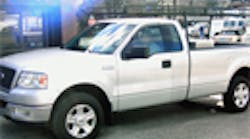Domestic auto and light truck sales dropped 2.5% overall in 2007 to their lowest annual level in over a decade and U.S. automakers expect further declines in 2008 due to the slumping economy. As a result, domestic U.S. automakers are looking to regions outside North America for sales growth to help keep their bottom lines on an even keel in the near future.
“It’s clear we’ll face some challenging headwinds in 2008,” said Rick Wagoner, chairman & CEO of General Motors in a recent meeting with automotive analysts in Detroit, pointing to weak U.S. auto industry sales volumes, high fuel prices, high commodity and steel prices, and mounting regulatory requirements as but some of the major challenges the industry is facing.
GM delivered 3.87 million vehicles in 2007, down 6% compared with 2006, and it expects retail market share to be flat for this year. For the fourth quarter last year, GM North America built 1.04 million vehicles (358,000 cars and 684,000 trucks), down 65,000 vehicles or 6% compared to the fourth quarter of 2006 when it produced 1.1 million vehicles (446,000 cars and 661,000 trucks). GM said its first quarter production forecast for 2008 remains unchanged at 950,000 vehicles (344,000 cars and 606,000 trucks).
Ford Motor Co.’s 2007 sales totaled 2.57 million, down 12% compared with 2006; though it said more than two-thirds of the decline reflected discontinued models. Ford’s December sales totaled 212,094, down 9%. Light truck sales were off 4.7% for the year, dropping to 1.73 million units from 1.82 million units in 2006.
Ford also expects the economic environment to remain challenging in 2008, expecting the U.S. auto sales rate to be in the range of 15.5 million to 16 million total units. “We are restructuring our business to be profitable at lower demand and changed mix and accelerating the development of new products people want to buy,” said Jim Farley, Ford’s group vp--marketing & communications.
For 2007, Chrysler LLC reported total sales of 2.07 million units, a decrease of 3% from the 2.14 million units sold in 2006. Sales of Dodge’s Ram pickup fell 2.2% for the year to 358,295 units compared to 364,177 units in 2006.
Even Japanese automakers believe 2008 will be a tough year for sales in the U.S., despite posting sales increases last year. “This was definitely a challenging year to be in the car business, and 2008 isn’t likely to be a piece of cake,” said Dick Colliver, executive vp of American Honda, which saw U.S. sales climb 4.5% overall for 2007. The division’s light-truck sales posted a record of 669,327 units sold in 2007, up 0.3% from 2006, with light trucks representing 43% of total vehicle sales for Honda in the U.S.
Toyota Motor Sales U.S.A., Inc., however, continued its strong showing in the U.S. – especially in the pickup truck market. It posted a 2.7% increase in total vehicle sales to 2.62 million units in 2007 versus 2006. Pickup sales were particularly strong, with total pickup sales rising 21.7% from 302,859 units in 2006 to 369,793 units last year. Sales of Toyota’s redesigned Tundra pickup soared 57.4% to 196,555 units in 2007, up from 124,508 units in 2006.
In the near future, U.S. auto manufacturers are counting on growth in global markets outside the U.S. to sustain their operations as they continue to retool their North American operations.
GM, for example, projects global industry volume to reach a record high of approximately 73 million units in 2008, up from about 71 million in 2007, with growth in Asia Pacific, Latin America, Africa and the Middle East and Europe – with U.S. industry sales likely be in the low 16-million range, reflecting continuing high fuel prices and sub-par consumer confidence.
Waggoner said GM would continue its aggressive plans to grow in emerging markets such as China, Brazil, Russia and India. “We’re starting our second century at a time of fundamental change in the auto industry,” he noted.




